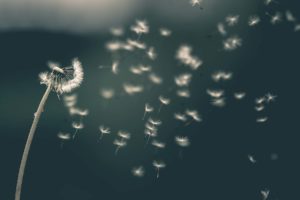A winding path through Kathy Welch’s garden leads to an oak grove. Photo by Saxon Holt.
Kathy Welch had already begun to consider renovating her yard in the Oakland hills when she made a few discoveries. “I found a trillium poking out. It was beautiful, a deep claret color. It had struggled through the ivy! I also found soaproot and California polypody.”
Polypody is a small fern that, like the wake-robin trillium, grows in shaded canyons along most of the California coast. The lot behind Welch’s house is long and sloping, and is defined by a small grove of coast live oaks whose lofty limbs provide a graceful counterpoint to the steep pitch of the land. Having been a docent at the UC Botanical Garden for more than a decade, Welch was able to spot the few native plants remaining under the oaks despite a sea of ivy swamping the trees.
At the time, she was already conferring with Michael Thilgen, a principal of Four Dimensions Landscape Development in Oakland, about ways to protect the oaks. He proposed a more ambitious project to restore a portion of the yard to the oak woodland it had once been. So began a dialogue about habitat restoration that led to the crafting of a sophisticated but accessible landscape that moves seamlessly from the built environment to the wild, from the dwelling of humans to the realm of wildlife.
Though very much anchored by the oaks, the quarter-acre backyard is also emphatically a garden. As you emerge from the house, your eyes fall to a small pond at the perimeter of the flagstone patio. Tall stalks of scarlet monkeyflower lean out over the water’s edge, leading the eye up and out over the entire yard. To either side of the pond, the upright plumes of a showy bunchgrass—not a native—block the view, creating a sense of enclosure.
The grasses along the patio have been planted parallel to the house, in order to echo its geometry. “The interaction of the exotic and the native—the architectural and the natural—comes into play throughout the garden,” says Thilgen. Here, closest to human habitation, the exotic and architectural take precedence.
Broad stone steps lead away from the patio. In sloping beds on either side of a landing are Welch’s kitchen garden and her flower beds filled with both native and exotic flowers, vege-tables, and herbs. The effects are stunning: Blue-gray grasses mingle with purple and burgundy flowers; lettuce grows amid a plethora of sharp-scented herbs.
Smaller stone steps laid directly in the soil and interspersed with woolly thyme wind through an exposed, south-facing slope planted with California natives that, Thilgen says, “evoke a chaparral community.” These hardy shrubs such as lavatera and St. Catherine’s lace are adapted to dry conditions and bright sunlight. Shrubs dominate now, but in the garden’s first year, Thilgen sowed wildflower seeds in this area. These annuals provided beauty and variety while the shrubs were setting root and gaining height. Wildflowers are great starter plants in any wildlife garden—many are easy to grow, and they attract a variety of pollinators.
Walking on decomposed granite now, you duck under a low oak limb and enter an open area under the oaks. “Here,” says Thilgen, “it gets to be more like a walk in the woods.”
Protecting the oaks was Welch’s highest priority. Having endured summer water, strangulation by English ivy, and other insults, the oaks were in decline when she arrived. She and Thilgen began to look around for understory species, plants that naturally occur under oaks. “To the extent possible, we put in what we could find in the watershed,” Welch said. Thilgen collected seeds locally and grew them at home—an ambitious project. California fescue, phacelia, and fringe cups now line the trail. Shade-tolerant shrubs grow here too: thimbleberry, snowberry, coffeeberry, and others. One can almost imagine the oaks above them breathing a collective sigh of relief.
When she wanders among the oaks, Welch says, “I feel that I’m in an oak woodland, and a lot of that has to do not only with the plants, but with everything else that comes to see you there.” At the Botanical Garden, Welch studied pollinators and flower types, and now she sees those relationships played out in her yard. Insectivorous birds—chickadees, nuthatches, bushtits—come to feed on the bees and flies that are, as she says, moving pollen in the garden.
From the bottom of the slope, you can look back up to the house, through the woodland, the chaparral, the flower beds. “There’s a good bit of leisure in this garden,” Thilgen acknowledges. “There’s enough length to establish a mood and then gradually move out of it, into something adjacent.” But he maintains that any garden can gracefully acknowledge the interplay between nature and humanity.
“Garden design,” says Thilgen, “can be a metaphor for human relations with the rest of nature. We are an industrial society; we don’t have much of an idea anymore how to work with the land. So that’s what this”—Thilgen gestures to the garden around him—”is about: exploring the possibilities.”

.jpg)



